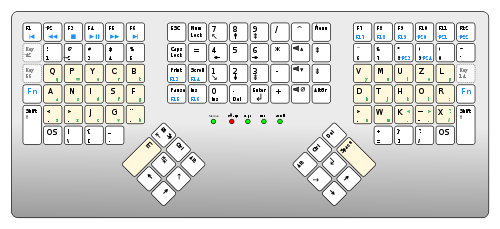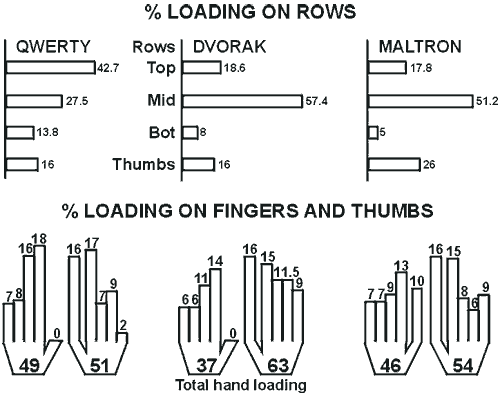Kinesis Advantage Keyboard Review
You have already seen it. A long time ago. In the movie "People in Black" (1997):

All humanoids in the MiB office use these (and the government is hiding!). Already a year I, too, all in black.
Next is an illustrated review of one of the most expensive ergonomic keyboards (and one of the few truly ergonomic). On the move from the more expensive I will mention only Maltron for ~ 450 pounds (manual assembly to order, including the most caring models for the disabled). There is also Datahand for only $ 995, but this is not really a keyboard, but an alternative tool for entering text).
')
1) The keys are located in two separated blocks, the distance between the F / A and J / O buttons is 21 cm (4 cm on laptops, 8 cm on MS Natural ), so the hands on the keyboard are straight, without a wrist in the wrist joint. The larger you are, the wider your shoulders, the stronger the effect of such a change will be.

The carpal tunnel syndrome will bypass you (the English Wikipedia recognizes its connection with long-term work at the computer, the Russian denies it). If you did not feel his approach - rejoice, a piece of vileness.
2) The keys are mounted on a concave surface, as if in a bowl.

The keys pressed by the little finger are higher because the little finger is shorter than its neighbors.
When typing, you do not need to reach anywhere, everything is in its place and requires a minimum of movements (a little further - at point 10 - there will be a spectacular video). Imagine that you just relaxed your hand and put it with your palm down, your thumb just above the little finger, no tension. Good oh.
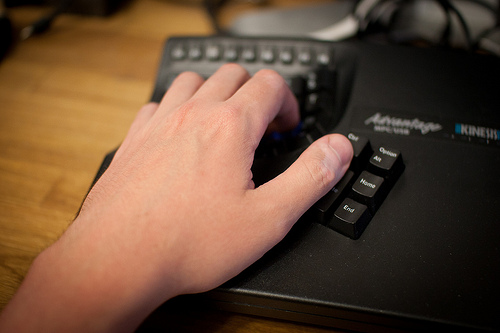
Where did such innovations come from?
3) The rows of keys are not offset relative to each other.

The shift came from typewriters, for such a solution was suggested because of the levers connecting the keys with hammers:
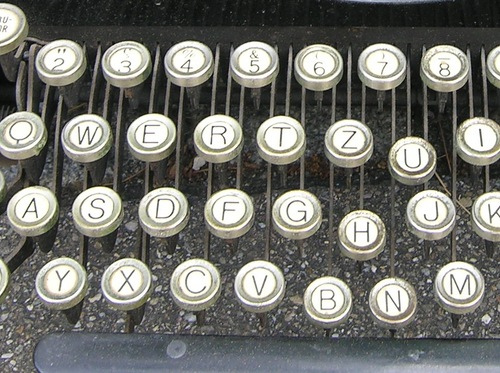
If you move your finger up or down on the kinesis from the starting position (Fold-Aldzh), it will fall on another key, and not in the gap between them.
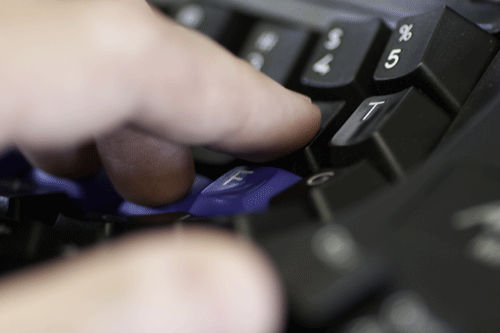
This is not such a trifle as it may seem. It is natural and comfortable.
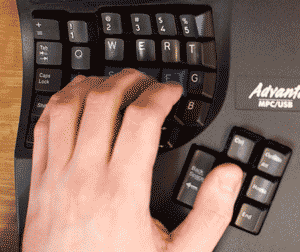
So it should be, this is right, and on the other Klava, an inconvenient and senseless tradition is traditionally reproduced:

4) No digital block. This is both a minus and a plus:
- it’s unusual for accountants
- it is inconvenient to play ADOM
+ the way to the mouse lying next to the keyboard becomes quite short; previously only left-handers enjoyed it.
Perhaps this is the difference that brought Kinesis out of the Maltron patent.
The numbers are entered either from the digital range or on the right alphabetic block, which, using a special keypad button, switches to the appropriate mode:
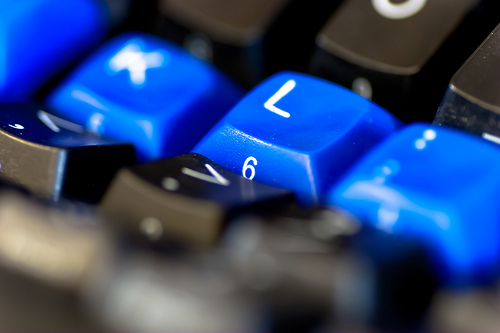
The radical solution is a separate numeric keypad or touchpad with a built-in calculator.
5) The control keys (Ctrl, Alt, AltGr, Backspace, Del, Space, Enter, Home, End, PgDown, PgUp) are placed under your thumbs. This is one of the main advantages of the keyboard, believe me. Combinations with Ctrl, which on ordinary keyboards force you to move your arms or bend your little finger, pressing the key almost with your fingernail, are minimalistic and lightning-fast here.
Newbies are usually frightened by the space available only for the thumb of their right hand, but in reality this is fine. And how beautiful Backspace and Del are, for which no need to reach, oh-oh.
On these keys you play like a slap bass:
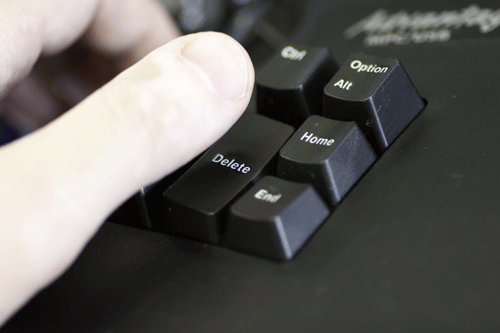
6) Arrow block divided into two parts - horizontal arrows under the left hand, vertical under the right. It’s hardest to get used to this, you need a lot of practice, but this also results in the maximum benefit in convenience , because now you can drive the cursor back and forth without removing your hands from the main position. In combination with convenient Ctrl this is just an editor.
divided into two parts - horizontal arrows under the left hand, vertical under the right. It’s hardest to get used to this, you need a lot of practice, but this also results in the maximum benefit in convenience , because now you can drive the cursor back and forth without removing your hands from the main position. In combination with convenient Ctrl this is just an editor.
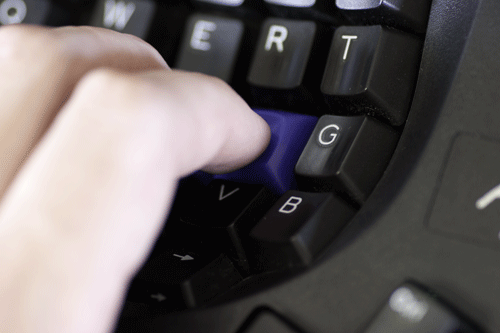
7) The main fac for the Russian-speaking: there is no place for E and b. Left-above Q is not E, but + =, E also crawled to the bottom, under Z. On the right, the letter strings end one key earlier than needed for the Cyrillic alphabet , so b was also at the bottom. There is also X, but it is easy to return to its usual place. Oddly enough, the outwardly fatal flaw in fact is not at all terrible.
I’m not allowed to use by my employers, the frequency of using Kommersant in Russian is a few hundredths of a percent, and the new position of these buttons is learned very quickly.
Of course, the Russian letters on the keyboard are not marked. However, it’s almost impossible to print blindly on it.
8) Plus (+) is to the left of the digital series, minus - to the right. Get used to it easily.
9) All keys are programmed - they are swapped, duplicated, macros (recorded sequences of pressing) are hung on their combinations. That is, you can score a couple of dozens of complex passwords in the keyboard, you can automate repetitive actions in any program (for example, macros
Ctrl + C, Alt + Shift + Space
Shift + End, Del
Ctrl + G, Enter
as well as the automatic dialing sequence [{M}] [{F}]).
It is important that the keyboard does not require a driver, and all programming is done by its hardware. Connect it anywhere, under any operating system everything will work the same.
10) Cherry MX Brown mechanical keys, without a click (there is a built-in speaker to simulate it), but with a tactile trigger alarm, several tens of millions of clicks to failure:
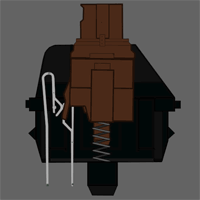
As a result, the keyboard is noisy, but after it the membrane is nasty to use, and scissor notebooks seem to be tight.
Video: Advantage + MX Brown in action
Historical fact: the MX Brown keys were created by Cherry specifically for such a keyboard, released in 1992 by Kinesis called Contoured. The customer wanted “like MX Blue, but without a click,” the customer received.
Also available is a modification of the LF with the Cherry MX Red keys, with a linear, unchanging resistance to pressing:

Video: Advantage LF + MX Red in action
Turning on and off modes CapsLock, NumLock, ScrollLock and Keypad is accompanied by a beep.
11) Esc, all 12 F-keys, as well as PrintScr, ScrollLock, Pause and a pair of service keys (Keypad and Program) are not mechanical, but rubber, like on pocket calculators. They work, but they are not encouraging, just like fake Christmas tree toys. I understand that this controversial decision was made only to save space.

12) You can connect foot pedals (Shift, Enter and Keypad by default, but you can reprogram), and you can embed additional buttons - the controller has unused channels.
13) NumLock, Insert, Win and Menu are available only from Keypad mode, or by reassigning to something else.
14) The keyboard is small (42x21 cm) and light. USB, there is a built-in hub for two ports.
15) There is a modification of Pro - double memory for macros, hardware protection against accidental reprogramming, one foot pedal included.
16) Immediately forgot to say - despite the fact that only QWERTY is marked on the keys, the keyboard can be instantly switched to Dvorak and back. There is a modification with a double legend on the keys.
Should I get involved?
If the money brings you work with the text - yes.
Appreciate yourself. Pamper yourself. Life is only one. Try the best, otherwise you will not know what you are losing. Do not spare money for working tools. Work with pleasure.
Additional materials:
Scanned article by Lilian Malt "Designing keyboards in the electronic age" (in English):
http://www.maltron.com/keyboard-info/academic-papers/236-lillian-malt-papers.html
Frequency of use of letters in various languages:
http://www.statsoft.ru/home/portal/exchange/textanalysis.htm
Photo base
Flexible printed circuit boards:
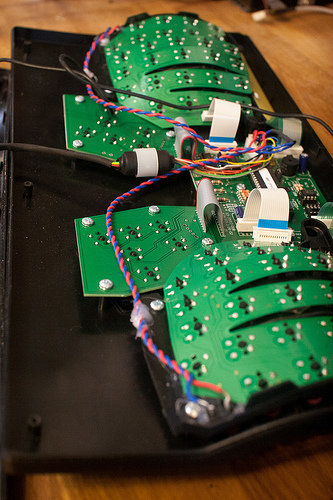
Everything entirely:
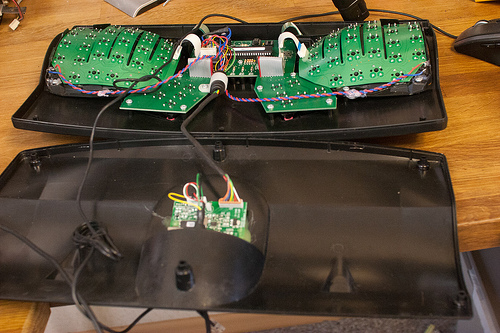
Brain:

Brain 2:

PS Initially, the keyboard was produced only in white; the batch of black color was released specifically for the shooting of Men in Black. After the release of the film there was a steady demand for a black model, which has since remained in the range.

All humanoids in the MiB office use these (and the government is hiding!). Already a year I, too, all in black.
Next is an illustrated review of one of the most expensive ergonomic keyboards (and one of the few truly ergonomic). On the move from the more expensive I will mention only Maltron for ~ 450 pounds (manual assembly to order, including the most caring models for the disabled). There is also Datahand for only $ 995, but this is not really a keyboard, but an alternative tool for entering text).
')
1) The keys are located in two separated blocks, the distance between the F / A and J / O buttons is 21 cm (4 cm on laptops, 8 cm on MS Natural ), so the hands on the keyboard are straight, without a wrist in the wrist joint. The larger you are, the wider your shoulders, the stronger the effect of such a change will be.

The carpal tunnel syndrome will bypass you (the English Wikipedia recognizes its connection with long-term work at the computer, the Russian denies it). If you did not feel his approach - rejoice, a piece of vileness.
2) The keys are mounted on a concave surface, as if in a bowl.

The keys pressed by the little finger are higher because the little finger is shorter than its neighbors.
When typing, you do not need to reach anywhere, everything is in its place and requires a minimum of movements (a little further - at point 10 - there will be a spectacular video). Imagine that you just relaxed your hand and put it with your palm down, your thumb just above the little finger, no tension. Good oh.

Where did such innovations come from?
It all started with Lilian Malt, who trained typists and retrained linotypists, replacing them with a computer keyboard. On the linotype keyboard, the letters are arranged in vertical rows according to the frequency of their use: ETAOINSHRDLU, etc. in English; OENA ISMVYGU - in Russian. Between A and I, i had been located before, after the spelling reform, its place was taken by a fine instrumentation .
The experience gathered and the observation of other people's mistakes led Lilian to the following ideas:
- place the keys on a concave surface, taking into account the different lengths of the fingers, so that you do not have to reach for the far buttons;
- change the QWERTY layout (created by Christopher Scholes at the end of the XIX century) so as to load fast and strong fingers as much as possible, removing the load from short and weak fingers. In particular, the letter E most frequently used in English (as well as a dozen more keys) must move under the thumb, which is given only a space in QWERTY (and that one with two fingers).
This is the layout:
Loading fingers when using three layouts - QWERTY, Dvorak and Maltron. Pay attention to the thumbs, little fingers and overall symmetry:
Then the inventor teamed up with engineer Stephen Hobdey , who helped translate the idea into hardware. Another thing is that so far PCD Maltron has not found an investor who would help her to launch mass production, and Hobday still solders the keyboards by hand . [Stephen Hobdey died on July 7, 2015 at the age of 98 years]
In general, the development process is a bit more complicated than screwing in a multi-colored backlight, WASD is red, Fn instead of Ctrl and a screen with a processor temperature, right?
Kinesis keyboards, as far as I know, have budded off from maltron's, somehow bypassing patent restrictions, and have since developed independently (having received the opportunity to program, in particular).
3) The rows of keys are not offset relative to each other.

The shift came from typewriters, for such a solution was suggested because of the levers connecting the keys with hammers:

If you move your finger up or down on the kinesis from the starting position (Fold-Aldzh), it will fall on another key, and not in the gap between them.

This is not such a trifle as it may seem. It is natural and comfortable.

So it should be, this is right, and on the other Klava, an inconvenient and senseless tradition is traditionally reproduced:

4) No digital block. This is both a minus and a plus:
- it’s unusual for accountants
- it is inconvenient to play ADOM
+ the way to the mouse lying next to the keyboard becomes quite short; previously only left-handers enjoyed it.
Perhaps this is the difference that brought Kinesis out of the Maltron patent.
The numbers are entered either from the digital range or on the right alphabetic block, which, using a special keypad button, switches to the appropriate mode:

The radical solution is a separate numeric keypad or touchpad with a built-in calculator.
5) The control keys (Ctrl, Alt, AltGr, Backspace, Del, Space, Enter, Home, End, PgDown, PgUp) are placed under your thumbs. This is one of the main advantages of the keyboard, believe me. Combinations with Ctrl, which on ordinary keyboards force you to move your arms or bend your little finger, pressing the key almost with your fingernail, are minimalistic and lightning-fast here.
Newbies are usually frightened by the space available only for the thumb of their right hand, but in reality this is fine. And how beautiful Backspace and Del are, for which no need to reach, oh-oh.
On these keys you play like a slap bass:

6) Arrow block
 divided into two parts - horizontal arrows under the left hand, vertical under the right. It’s hardest to get used to this, you need a lot of practice, but this also results in the maximum benefit in convenience , because now you can drive the cursor back and forth without removing your hands from the main position. In combination with convenient Ctrl this is just an editor.
divided into two parts - horizontal arrows under the left hand, vertical under the right. It’s hardest to get used to this, you need a lot of practice, but this also results in the maximum benefit in convenience , because now you can drive the cursor back and forth without removing your hands from the main position. In combination with convenient Ctrl this is just an editor.
7) The main fac for the Russian-speaking: there is no place for E and b. Left-above Q is not E, but + =, E also crawled to the bottom, under Z. On the right, the letter strings end one key earlier than needed for the Cyrillic alphabet , so b was also at the bottom. There is also X, but it is easy to return to its usual place. Oddly enough, the outwardly fatal flaw in fact is not at all terrible.
I’m not allowed to use by my employers, the frequency of using Kommersant in Russian is a few hundredths of a percent, and the new position of these buttons is learned very quickly.
Of course, the Russian letters on the keyboard are not marked. However, it’s almost impossible to print blindly on it.
8) Plus (+) is to the left of the digital series, minus - to the right. Get used to it easily.
9) All keys are programmed - they are swapped, duplicated, macros (recorded sequences of pressing) are hung on their combinations. That is, you can score a couple of dozens of complex passwords in the keyboard, you can automate repetitive actions in any program (for example, macros
Ctrl + C, Alt + Shift + Space
Shift + End, Del
Ctrl + G, Enter
as well as the automatic dialing sequence [{M}] [{F}]).
It is important that the keyboard does not require a driver, and all programming is done by its hardware. Connect it anywhere, under any operating system everything will work the same.
10) Cherry MX Brown mechanical keys, without a click (there is a built-in speaker to simulate it), but with a tactile trigger alarm, several tens of millions of clicks to failure:

As a result, the keyboard is noisy, but after it the membrane is nasty to use, and scissor notebooks seem to be tight.
Video: Advantage + MX Brown in action
Historical fact: the MX Brown keys were created by Cherry specifically for such a keyboard, released in 1992 by Kinesis called Contoured. The customer wanted “like MX Blue, but without a click,” the customer received.
Also available is a modification of the LF with the Cherry MX Red keys, with a linear, unchanging resistance to pressing:

Video: Advantage LF + MX Red in action
Turning on and off modes CapsLock, NumLock, ScrollLock and Keypad is accompanied by a beep.
11) Esc, all 12 F-keys, as well as PrintScr, ScrollLock, Pause and a pair of service keys (Keypad and Program) are not mechanical, but rubber, like on pocket calculators. They work, but they are not encouraging, just like fake Christmas tree toys. I understand that this controversial decision was made only to save space.

12) You can connect foot pedals (Shift, Enter and Keypad by default, but you can reprogram), and you can embed additional buttons - the controller has unused channels.
13) NumLock, Insert, Win and Menu are available only from Keypad mode, or by reassigning to something else.
14) The keyboard is small (42x21 cm) and light. USB, there is a built-in hub for two ports.
15) There is a modification of Pro - double memory for macros, hardware protection against accidental reprogramming, one foot pedal included.
16) Immediately forgot to say - despite the fact that only QWERTY is marked on the keys, the keyboard can be instantly switched to Dvorak and back. There is a modification with a double legend on the keys.
Should I get involved?
If the money brings you work with the text - yes.
Appreciate yourself. Pamper yourself. Life is only one. Try the best, otherwise you will not know what you are losing. Do not spare money for working tools. Work with pleasure.
Additional materials:
Scanned article by Lilian Malt "Designing keyboards in the electronic age" (in English):
http://www.maltron.com/keyboard-info/academic-papers/236-lillian-malt-papers.html
Frequency of use of letters in various languages:
http://www.statsoft.ru/home/portal/exchange/textanalysis.htm
Photo base
Flexible printed circuit boards:

Everything entirely:

Brain:

Brain 2:

PS Initially, the keyboard was produced only in white; the batch of black color was released specifically for the shooting of Men in Black. After the release of the film there was a steady demand for a black model, which has since remained in the range.
Source: https://habr.com/ru/post/146353/
All Articles
